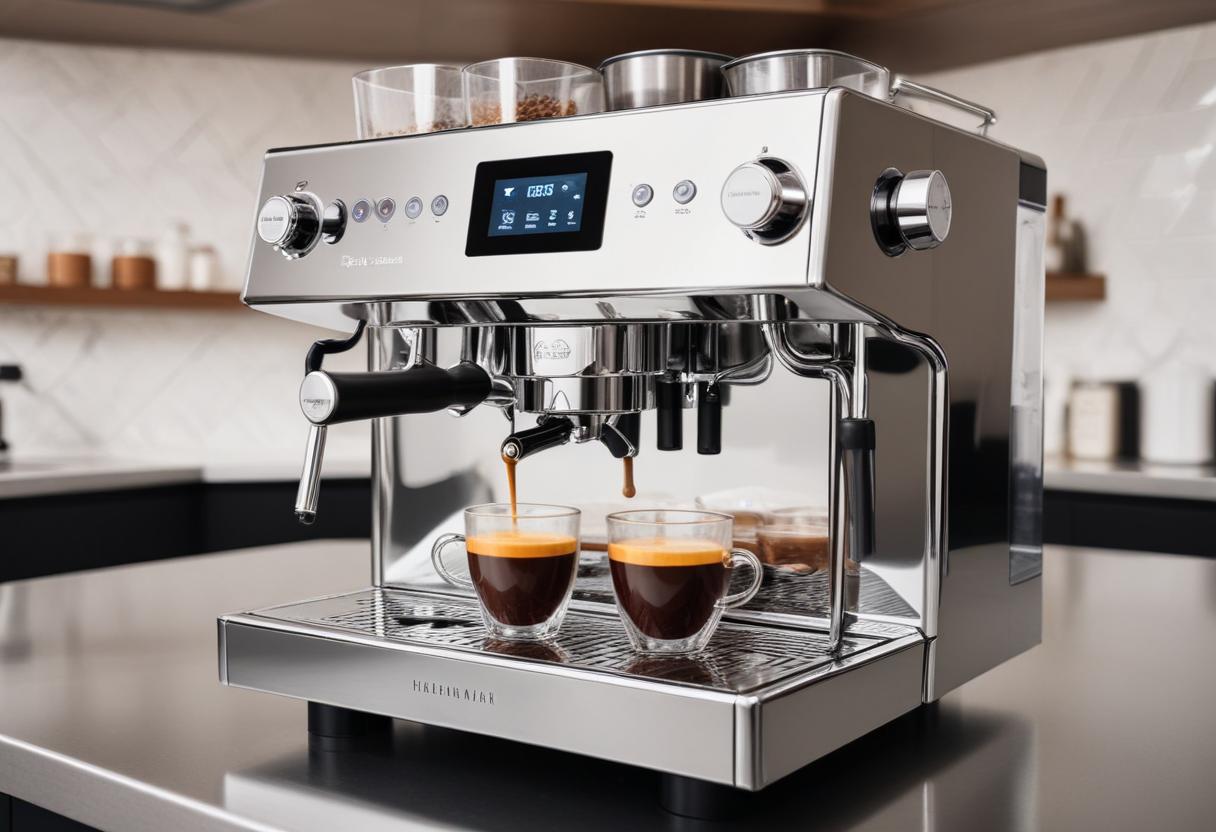Breville (ASX:BRG): Will consumer demand for $4500 coffee machines offset the impact of Trump’s tariffs?

Breville (ASX:BRG) is one of those consumer stocks caught in the crosshairs of Trump’s tariffs and fell 30% in 2 months earlier in 2025. But its most recent annual results have given hope that customers may be willing to pay a premium for its goods.
What are the Best ASX Consumer Stocks to invest in right now?
Check our buy/sell tips
Who is Breville?
This company is a premium kitchen appliances business with a presence in Australia, Europe and the Americas. It was founded in 1932 – founded from capital obtained from a successful 4-to-1 bet at the 1932 Melbourne Cup.
In the last 12 months, Breville sold $1.7bn in over 100 countries globally and caters to middle to higher income earners. It is headquartered in Sydney, has manufacturing facilities in China and regional offices in key markets.

An example of Breville’s coffee machines
Battling through post-pandemic headwinds
Breville listed in 1999 and has achieved growth of over 2000% since. In the last 10 years it has grown revenue, gross profit and EBIT every single year. It had a subdued period immediately post-pandemic for a number of reasons including fears that inflation would impact demand, specific weakness in Europe due to the war in Ukraine, supply chain issues and the high inventory uplift (peaking at over $400m). None of these were as bad as feared, even if company had to take certain steps, such as acquiring Italian coffee machine maker Lelit in mid-2022.
In FY24, Breville generated $1.53bn revenue (up 3.5%), $245.5m EBITDA (up 12.5%) and an $118.5m profit (up 7.5%). It recorded a 36% gross margin. The 4% revenue growth was hardly earth shattering, but follows 3 years of revenue growth of 19-25% during the pandemic.
And it was a fair achievement to be in positive territory, with a strong second half, not to mention how the company recovered inflation and finance costs as well as keeping inventory levels from spiralling out of control. It paid a full year dividend of 33.0c per share, 100% of which was franked and it represented an 8% gain from the year before.
Trump’s tariffs are a new headache for Breville
Trump’s tariffs have been the biggest concern with Breville’s investors. Even with 10% sales growth in 1H25, shares lost 30% in the first few months of 2025. They came right as the company sought to make a major entry into China, having made goods there but not sold goods there. The company proactively stockpiled goods in anticipation of tariffs and raised the prospect of setting up manufacturing facilities outside China.
But 6 months on, it seems Breville investors have just about forgotten about tariffs as it replaced its 10% revenue growth in the full year and it also recorded 10% growth on the EBIT line. Its profit was $135.9m, up 15% too, and it made a 14.9% Return on Equity. It paid 37c per share. The company flagged a significant input cost increase over the next couple of years for US-based sales given the tariffs. Breville plans on pursuing multiple mitigating strategies including diversified sourcing locations and selective pricing.
For now, it seems investors are drawn in by the demand for coffee in China as well as the company’s latest machines in other markets. It just launched the Oracle Dual Boiler coffee machine that has a $4500 price tag – the highest in the company’s history. Demand for air fryers has helped too.
What does the future hold?
The big concern is the impact of tariffs. Breville has admitted,’ It is too early to predict how the various forces will play out across the next 12 to 18 months, a period of undoubtedly higher input costs for US products, coupled with potential second and third order effects globally’, although indicated it could give FY26 guidance at its 1H26 results (due in February 2026).
Analysts call for $1.9bn in revenue and a $138m profit representing 10% and 3% growth respectively. Clearly, there will be an impact to the bottom line, but analysts think it won’t be big enough to snap a decade-long streak of bottom-line growth. FY27 is expected to be a year of stronger growth with $2.06bn revenue and a $160m profit.
However, their mean target price is $34.64, a discount to the $36.19 share price recorded just after the results. And even with these growth estimates, the company is 37x P/E, 3.3x PEG and 18x EV/EBITDA for FY26. Investors need to decide if they are fine with these multiples.
Why we’re confident about Breville
We think there are three reasons why Breville can grow. First, it’s track record of sales growth. Second, the company’s experience in successfully entering new markets. The third reason is the market the company is in. Breville offers premium and functional goods, targeted at consumers with higher disposable income. Even if its consumers are feeling the pinch, they might view upfront investments in Breville’s products – coffee machines, ovens and juicers – as saving money in the long run. And consumers already with appliances and needing new ones won’t put off purchasing a new one for too long.
One of the best consumer discretionary companies out there
We are bullish on consumer discretionary stocks that won’t be impacted by tariffs. The challenge is that in Breville’s case, it is not because it is exempt but its consumers will be willing to pay up.
Blog Categories
Get Our Top 5 ASX Stocks for FY26
Recent Posts
Develop Global Wins $200m OceanaGold Contract- What It Means for Investors
Develop Global (ASX: DVP) climbed 4% to A$4.36 on Friday after securing a A$200 million underground development contract with global…
Nova Minerals Drops 14% on $20m Capital Raise- Buy or Avoid?
Nova Minerals (ASX: NVA) dropped nearly 14 per cent to A$0.90 following the announcement of a US$20 million (approximately AUD…
WiseTech (ASX:WTC) Rises After Richard White Cleared of Misconduct – Should You Buy the Dip?
WiseTech Global (ASX: WTC) climbed 3 per cent to A$70.18 on Friday after founder and Executive Chairman Richard White was…



